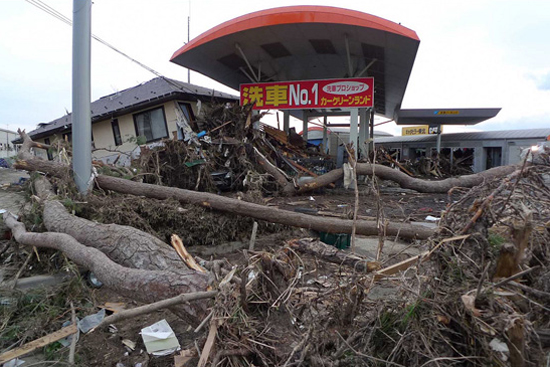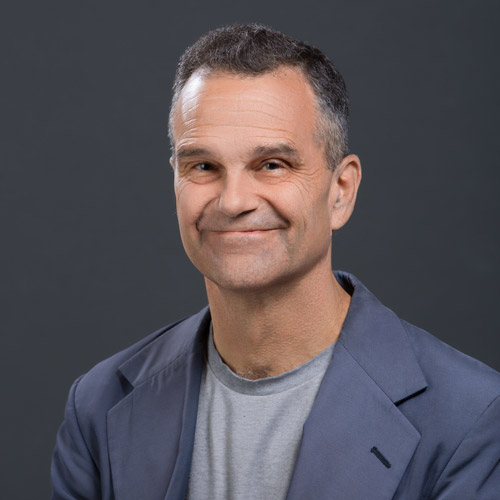Eyewitness to Disaster
CAS astronomer recounts surviving Japanese earthquake

“It’s nice to be alive.”
Michael Mendillo’s answer to the everyday question “How are you?” is not typical. But your typical person hasn’t huddled under a makeshift lean-to to avoid falling debris during the worst recorded earthquake in Japanese history, or watched a tsunami wash in literally beneath his feet, or been detoured away from disabled nuclear plants threatening to irradiate him.
Mendillo (GRS’68,’71), a College of Arts & Sciences astronomy professor, was in the Japanese city of Sendai for an international planetary astronomy meeting during the week leading up to the March 11 quake-cum-tsunami. What had been an honor—an invitation to be one of just five non-Japanese speakers at the conference—turned into a nightmare after he found himself the lone American stranded for almost two days with 1,400 others at the Sendai airport as the disaster unfolded.
Catastrophe carved indelible details into Mendillo’s memory: times, conversations, the umbrella covering the airport table where he sipped coffee as he waited (vainly, it turned out) to flee the country after the worrisome tremors that were overtures to the earthquake. He started a diary minutes after the quake to alleviate his terror at what had just happened, and what might be still to come. He relived the ordeal in an interview with BU Today.
Premonition of tragedy
The first trouble signs came Wednesday, March 9, during the meeting at Tohoku University in Sendai, a northeastern coastal city 170 miles from Tokyo. A 7.2 quake shook the building as Mendillo sat in the audience during the morning session. Having heard that you should stand in a doorjamb during a quake, he bolted for the conference room’s jamb, only to feel mortified when he realized that he was the only one who did. The Japanese speaker, insouciant about such things, had resumed his talk.
“To save face,” says Mendillo, “I just continued on to the men’s room.”
That night, an aftershock woke him. “The hotel was shaking at 3 in the morning. I weathered that in bed,” but when another tremor woke him at 6—looking outside from the 17th floor, “I could tell that we were swaying”—he resolved to leave Japan a day early, on Friday. He booked a flight for that afternoon at 4 o’clock.
At the airport, Mendillo checked his roll-on suitcase, something he came to regret later, as “that resulted in my staying in the clothes I was wearing for the next five days.” He planted himself at a table near the balcony in the cavernous third floor atrium, took out his laptop, and opened a paper he was writing with colleagues about Mars, getting a half hour’s work in.
Then the table started shaking.
The furies unleashed
At first, the shaking was minimal, like turbulence rattling a plane or rough waters jostling a ferry, Mendillo says. Still, “I decided it wasn’t wise to be at the edge of the balcony.” He retreated to the center of the atrium. The shaking escalated violently, and his eye fell on a children’s museum with two large signs in front. As people screamed in the chaos, he grabbed the signs, angled them against a railing, and scampered under the improvised lean-to, holding it in place with his hands and feet. A dislodged wire sparked overhead, and a tile fell from the wall. He realized he couldn’t save himself if the whole roof collapsed, but “at least I could prevent myself from being hit in the head with a wall tile—what a stupid way to die.”
The quake’s peak strength lasted five minutes, giving Mendillo the sensation that the floor was being hoisted up and down about three or four inches. “The noise was unbearable,” he recalls. He thought, or maybe shouted out, “It’s not supposed to be this long!” It was the only time during the disaster, he says, that he thought he might die.
When it finally stopped, the rather obvious announcement in Japanese that all flights had been canceled for the day came over the intercom, along with instructions for everyone to head outside. He joined the exodus to the parking lot in front. While gazing at the hulking, still-standing glass terminal—a tribute to the architecture and engineering of the Japanese, he says—a man who spoke English told him that cell phones were alive with messages about a tsunami. “It’s 30 feet tall,” the man said, “and we’re about 20 feet above sea level here, and we’re only two miles from the ocean.” Even a nonscientist could do the math: hightail it to the terminal’s top floor or perish.
As the crowd filed upstairs, a group of young women gently guided the 66-year-old Mendillo by the hand in “what got to be a real pattern, the respect and care for senior citizens,” he says. For 40 minutes, everyone milled on the third floor. He befriended an elderly Japanese couple; the wife spoke some English and explained they were on a senior citizens’ tour of health spas and hot springs. As they scanned the horizon from the balcony window, they could see a white ridge atop the distant blue ocean—a wall of water bearing down on them. The white shaded brown as the tsunami made land and mixed with soil. At exactly the time he’d been scheduled for wheels up, water swept into the parking lot and flooded the terminal’s first floor. “We saw all those cars picked up—what you’ve seen on CNN,” he says. “It looks like slow motion when the cars and houses come by, whole trees.”
“The tsunami was bizarrely unthreatening. We were up on this third level. We were watching a tsunami as if it were a silent movie. No sound, because we were in this gigantic glass bubble.”

Stranded
Unaware that the disaster had just killed 20,000 (the anticipated toll, authorities now say, once all the missing are accounted for), Mendillo spent Friday night to Sunday morning in alternating states: boredom at being stranded mixed with extreme discomfort (with no heat, the Japanese winter kept daytime temperatures only in the 40s, and when the sun went down, the terminal turned freezing inside). Although he was with hundreds of people, he says, “I felt pretty isolated.” He spoke no Japanese, only a handful of his fellow fliers spoke English, and no one had access to the Internet.
It was now obvious they were trapped for who knew how long. The floodwaters would not recede for a day or more, making a seabed out of the tarmac and parking lot. Airport staff struggled to make people comfortable, passing out masks to ward off airborne dust from all the shaking. They handed out blankets and even bubble wrap for warmth, but despite being bundled in his winter coat, scarf, and gloves and covering himself with bubble wrap on a chair where he sought sleep Friday night, “I was freezing after about four or five hours,” Mendillo says. At one point, he moved to warmer offices off the atrium. Twice that night, aftershocks sent him and the elderly couple he’d met earlier under his lean-to.
Saturday afternoon, with the floodwaters receding, an airline worker found Mendillo’s battered, waterlogged suitcase outside. He killed several hours trying to wash his muddied clothes in buckets of water. His computer case had his only English-language reading material, and it was apt: a book he’d begun about what makes a meaningful life. “I read most of it in these long, boring afternoons,” he says. “It got me to focus on the important things—I’m alive.”
He took long walks through the airport, amazed at the absence of looting. At one newsstand, people had left money for items they’d taken. Food and drink were not a problem as they were in an airport, and even airport food was luxurious compared to the heating situation. Mendillo sunned himself several hours on the roof to escape the chilling cold indoors.
Escape
Sunday morning, a nearby town sent two buses to the stranded fliers. Mendillo and his Japanese tour friends boarded one and were driven to the town, where his companions made hitchhiking signs in Japanese. (Mendillo’s got a laugh: “Help me, I’m an American.”) They hitched 25 miles to the Sendai bus station, where a bus took them to Yamagata, the only functioning airport in northern Japan. Mendillo spent the night in a hotel, where he enjoyed his first shower in three days and was able to phone his wife. She had “optimistically assumed I was OK,” as family members had scanned TV news scenes of the Sendai airport with magnifying glasses, hoping to glimpse’ his Red Sox cap. (Alas, he’d left the cap at home.) Monday morning, with all flights full, he got in a long line for a bus ticket to Tokyo. A friendly Japanese woman asked if he was being cared for, even berating the airport manager for not providing him with more timely information, and when Mendillo told her he taught at BU, “she said, ‘Oh, I’m CLA’99!” (CLA is the acronym for the former name of CAS.)
He boarded a bus and began a 10-hour drive to Tokyo, a longer-than-usual run, he was told, as the buses had to detour inland to avoid the fireballs of malfunctioning nuclear plants on the coast. Only then did Mendillo learn of the country’s nuclear crisis. He was treated to a spectacular drive through snow-covered mountains, “the tourist’s dream,” finally arriving in Tokyo at 10 p.m. Bone-tired, he slept in an airport hotel, managing to rouse himself with a 4:30 a.m. wake-up call. He was ready to leave at 5 when nature gave him his final send-off: yet another aftershock rocked the building. He recalls thinking “enough is enough, in stronger language.” He bid Japan farewell on a 6:55 a.m. flight to Detroit, and flew from there to Boston. Riding up an escalator in the Logan terminal, he says, “I saw my two children and my wife at the top of the escalator, sort of a light at the end of the tunnel.”
Lingering impressions? For one, the stoicism and kindness of the Japanese, including a colleague at the conference, who tried unsuccessfully to drive to the Sendai airport to retrieve Mendillo after the earthquake subsided. “The care I received, being a foreigner and older than the average population at the airport, was just phenomenal.” He’s not emotionally ready to return, however, as “I’m not going to go anywhere that’s seismically active for a while.”
One image haunts him. On Thursday, the last day of his conference, attendees enjoyed a cruise off a small fishing village and dinner at a coastal hotel. “I think they’re all dead,” Mendillo says somberly of the local residents. “That was the place where the tsunami would have first reached land. If it had come 24 hours earlier, we would’ve been on the water. That’s a real difficult thing to think about. If they had 40 minutes warning and could get to high ground, maybe they did. I’d like to think they did.”
Rich Barlow can be reached at barlowr@bu.edu.

Comments & Discussion
Boston University moderates comments to facilitate an informed, substantive, civil conversation. Abusive, profane, self-promotional, misleading, incoherent or off-topic comments will be rejected. Moderators are staffed during regular business hours (EST) and can only accept comments written in English. Statistics or facts must include a citation or a link to the citation.